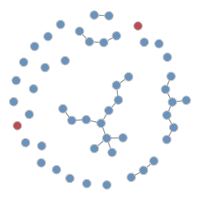20 Introduction
This module demonstrates how to use EpiModel to combine a statistical model for a dynamic contact network (using Temporal Exponential Random Graph Modeling) into a dynamic individual-level model for infectious diseases.
We will start with a brief lecture (slides) below to describe the types of modeling we will be doing in this module, and then move to a hands-on demonstration of the process using EpiModel.
20.1 Slides
20.2 Part I: Single Group Models
20.3 Module Learning Objectives for Part I
- Describe conceptually how to integrate a TERGM with an individual-level epidemic model using EpiModel.
- Parameterize a basic network-based SIS epidemic model, diagnose the model, and run the epidemic simulation in EpiModel.
- Extract and analyze the numerical data from the EpiModel object.
- Plot and visualize the epidemic from the EpiModel object.
20.4 Part II: Multiple Group Models
This part builds on the basics of network-based epidemic modeling with TERGMs using EpiModel demonstrated above. Here, we focus on working with a special group nodal attribute that can be flexibly used in built-in network models with EpiModel to represent basic population heterogeneity.
We will build an SIR (susceptible-infected-recovered) model on top of a network representation that involves differences in concurrency by group.
20.5 Module Learning Objectives for Part II
- Parameterize population heterogeneity in the network degree distribution by dichotomous groups.
- Parameterize an SIR epidemic model in EpiModel.
- Summarize and and visualize group-specific epidemic outcomes from the SIR model.
- Visualize a transmission tree of the epidemic with a phylogram.
